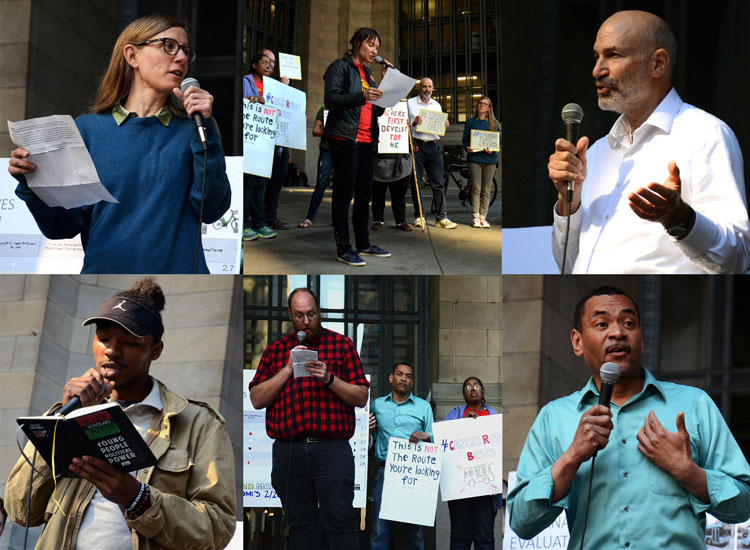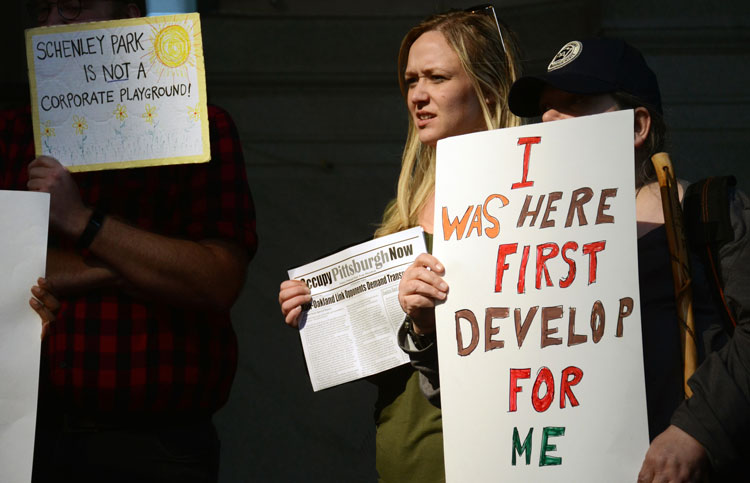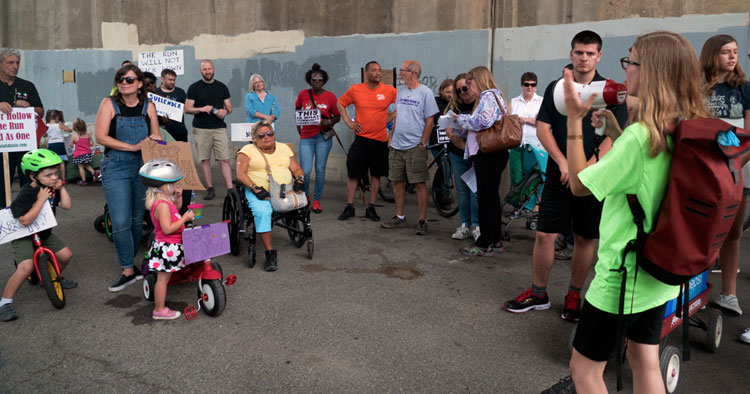
An OPN News Special Report
With the Fall 2018 release of Pittsburgh’s Amazon bid titled Future. Forged. For All., citizens learned the details of the secret deal: local officials had promised billions of dollars of public money and more to Jeff Bezos (who according to news reports accumulates $171,000 a minute, and whose personal wealth increased by $6.28 billion during last December’s Black Friday to Cyber Monday consumption-fest).
The bid included numerous perks: large swaths of public property, dedicated transit lines, and an autonomous vehicle shuttle through Schenley Park. It also contained a letter from Pittsburgh Public Schools (PPS) with the signature of board member Kevin Carter—who says he never saw nor signed the letter. An internal investigation was launched about the alleged forgery, but has produced inconclusive results as to who signed Carter’s name. Collective outrage lingers about the enormous giveaway of public money and land—and how the deal was defiantly conducted in secret, particularly within the communities of Panther Hollow and Four Mile Run (The Run). The autonomous shuttle promised in the Amazon bid is the same roadway project that residents of both Pittsburgh communities have been fighting since August of 2015.
The Mon-Oakland Connector (MOC), formerly called the Oakland Transit Connector, is exclusively for the Hazelwood Green (HG) development, a mile from The Run. Since the shuttle plan’s surprise announcement in the Post-Gazette in 2015, and the discovery of a URA-filed state of PA grant application that contained numerous falsehoods, residents have demanded yet not received transparency regarding the project from their local government representatives. Opponents assert the MOC plan is a private development deal forged behind closed doors to gentrify and erase their neighborhoods off the map.
During the Amazon sweepstakes, local politicians pitched the Hazelwood site for free to the world’s richest man, but now Amazon’s rejection has brought the roadway project’s original intent full circle. The primary benefactors of the egregious giveaway are once again Pitt and CMU, the foundation owners of the HG site, real estate speculators—and, many believe, Pittsburgh’s “Amazon”: UPMC. Some opponents believe in addition to AV shuttles every five minutes, Mon-Oakland Connector traffic will include VIPs using the road as their own private shortcut between Oakland and Hazelwood. As reported in OPN’s March 2018 article on this issue, a Parks Conservancy employee revealed, “No one will sign onto [the Hazelwood Green site] unless [the roadway is] built.”
Complicating the issue is the long overdue and much needed Four Mile Run Watershed Improvement Plan, a major project to alleviate flooding throughout the area, and to separate storm and wastewater from the city’s sewer system as mandated by the federal Environmental Protection Agency. Flooding has increasingly plagued Run residents for several years. As the Pittsburgh Water and Sewer Authority (PWSA) leads the watershed project, city officials are attempting to shoehorn the roadway project onto that plan despite serious viability questions the road would introduce.
Additionally, opponents assert the plan is not a public transportation project as advertised, evidenced in part by Allegheny County Port Authority’s (PAT’s) non-participation. Pittsburgh’s Department of Mobility and Infrastructure (DOMI) director Karina Ricks (KR) first stated at a November 2017 public meeting and two subsequent meetings that PAT is a partner in the roadway project. At a January 2018 public meeting she was asked by a PAT bus driver (BD), “What is the Port Authority’s role in this project?”
KR: Specifically their role is as a partner and as one of the mobility service providers in this area.
BD: So then PAT is a stakeholder like anybody else currently involved? Is that what you’re saying?
KR: They are a partner just like… as an institutional public partner.
Ms. Ricks announced that a PAT spokesman was in attendance, saying, “He’s here from the Port Authority and may answer some questions.” But PAT Senior Government Relations Officer Dan DeBone did not make himself known to the room, and soon after left the meeting. When contacted the following day and asked to confirm Ms. Ricks’ implication of participation by the public transit agency, Port Authority spokesman Adam Brandolph said, “We are aware of the project, but we are not involved.

Residents have proposed viable alternative shuttle routes, but the city continues maneuvering to push the private-partner-preferred invasive route over adamant objections.
At the January 2018 public meeting, consulting firm Michael Baker International presented six possible routes including those offered by residents. Referring to large maps, they added commentary about each alternative that some attendees said was disparaging and unenthusiastic toward all possibilities other than the originally proposed route. Each alternative was accompanied by comments such as “This seems unlikely” and “This would cost a lot.”
Afterward, attendees were ushered to sit at tables with at least two members of Michael Baker. At each table, the original, private-partner-preferred route had been placed at the top of the stack of maps. With only enough room to view one map at a time, most groups spent the majority of time discussing that specific route. Some residents and other attendees stated they were being “herded like cattle” to a pre-ordained conclusion: that the original, private-partner-preferred route was mandated to be the only viable option. At the end of the presentation and table breakout session, an attendee who gave his name as R.J. remarked, “I feel like I was just at a time-share meeting.”
Throughout early 2018, DOMI led residents to believe that the route would be changed to skirt the community and would not touch down on neighborhood streets. But at a subsequent May 22, 2018 public meeting, officials were walking back those agreements and blaming the railroad company whose property cuts along a hillside at the edge of The Run. DOMI and others pushing the project have made statements such as, “The railroad is… they’re just evil” and “They’re really hard to work with.” But blaming the rail company for a lack of clearance between the tracks and the proposed roadway route seems disingenuous. Walking the route and measuring the distance between the railroad’s right-of-way and the neighborhood confirms there isn’t enough physical space available without commandeering neighborhood streets and property—a fact opponents of the plan have known from the beginning. Also, the proposed route cuts through the center of a small parklet in The Run—land owned by the “evil” railroad company.
After the May 22 meeting, DOMI went silent. Residents of Panther Hollow and The Run sent a letter to DOMI on July 19, 2018, with an attached 457-signature petition previously sent to Mayor Bill Peduto in 2016. Just as the Mayor ignored the petition, DOMI never formally responded to the letter demanding transparency and a halt to the roadway plan. As of press time, DOMI has not held or even announced another public meeting.
Throughout the three-plus year process, several incidents have occurred, including:
- When asked at a November 2017 public meeting if the proposed roadway would still move forward if Amazon came to Pittsburgh, DOMI director Ricks replied that the density caused by Amazon’s presence would make the roadway obsolete and that other alternatives would have to be explored. After Amazon’s rejection of Pittsburgh’s bid that included the Hazelwood site, HG developers made last-minute changes to their community-vetted plan: limits in areas that allowed for three- to 10-story buildings increased to 15-24 stories—a tripling of density. Those changes bring the density closer to Amazon levels, yet the roadway plan has not been declared inadequate. Some believe Pittsburgh’s Planning Commission approved the changes to HG’s plan without a proper public process; they voted despite receiving a letter from the Greenfield Community Association asking for a delay in any decision, as well as a letter from the Run Resident Action Team demanding a thorough public process before any vote be taken.
- According to residents, a rumor-mongering campaign began sometime in 2018. Social media posts and whispering tactics inferred that residents of The Run are opposed to the roadway project because the neighborhood is racist, presumably in order to sow discord and help bully the project through.
- After the May 22 public meeting, three employees of Civil and Environmental Consultants (CEC)—the firm tasked with the Watershed project design—asked a few residents if they’d be willing to take an offer to vacate their homes and community. Residents responded by asking where they would go since every neighborhood in the city is now unaffordable.
- At a National Night Out community picnic in Greenfield on August 7, 2018, Run resident Kristen Macey noticed the arrival of Allegheny County Executive Rich Fitzgerald, an early cheerleader for the project. Ms. Macey shared her reasons for opposing the plan, asking: “I would like to know, why is putting this roadway in so important to you?” Fitzgerald answered, “This isn’t for you; this is for the universities to get down to the Hazelwood [Green] plan.” Fitzgerald asked Ms. Macey what street she lived on, and after her reply said, “Your property values are gonna skyrocket; they’re gonna go through the roof!”—while throwing his hands in the air, mimicking what seemed to be fireworks, according to Ms. Macey. She replied that she wasn’t interested in skyrocketing property values but in a safe, affordable community that doesn’t flood, and without another highway running through it.
- After contacting DOMI with their demands for transparency and a halt to the project, a resident discovered that DOMI filed an application for federal money in April to help finance a portion of the roadway, and that it was approved in July by the Southwestern Pennsylvania Commission (SPC). They contacted their City Councilman, asking him to provide information on the application filing and any other pertinent information. After a weeks-long exchange of emails and texts, Councilman O’Connor eventually emailed a cryptic reply with an incorrect amount of money requested in the application (“50000”).
If you don’t have a seat at the table, you’re probably on the menu. —Elizabeth Warren
On September 26, the Pennsylvania Department of Transportation held a public meeting regarding major changes to several intersections within a mile of the Hazelwood Green development. DOMI director Karina Ricks (KR) attended and afterwards, was asked a few direct questions:
OPN: Ms. Ricks, regarding the controversy of this roadway issue and the two neighborhoods still opposed to it, the city has all along said that this process has been transparent—but we’ve just learned that you filed a grant proposal for the roadway without informing residents. How is that transparency, if you never notified residents of the application filing or notify them beforehand?
KR: Well, many times, these grants come up every year or two and the opening [for filing] is about 60 days? And so we’ll probably ignore it for 30 days…
OPN: So you still had at least 30 days to notify residents before applying for the grant?
KR: Well… we could have handled that better.
OPN: Do you remember when it was filed?
KR: Sometime… I believe in the spring.
OPN: Actually it was filed on April 13 for a million dollars and signed by your assistant director, which was before the May 22 public meeting. How can you claim transparency if you didn’t let residents know you were filing the application? Ms. Ricks, there’s no such thing as partial transparency. Wouldn’t you agree?
KR: Well, let me… I know there… It’s not possible for there to be some conspiracy—we’re just not competent enough for that.
Within a week, Ms. Ricks sent residents a PDF of the application, but with cut-off paragraphs in the boxes within the application document. On October 11, after additional requests and an in-person visit to SPC (the organization that approved the grant money) Panther Hollow resident Carlino Giampolo received more of the information requested.
In November of 2018, the PWSA held a public meeting with CEC to unveil the newest design of the Four Mile Run Watershed Improvement Plan. According to Megan Ziegler of PWSA, the flood mitigation plan and the roadway plan “are two separate projects,” that money for the watershed plan is already in place, and “No one is telling us how to do it [the flood mitigation].” She assured meeting attendees that “No matter what, this [watershed] project is going to happen.” But examining the preliminary design makes the claim of autonomy seem like a distinction without a difference. The architectural drawings of both neighborhoods and the Junction Hollow section of Schenley Park includes a 20-foot wide pathway. CEC engineer Brad Hazelwood called it a “maintenance road” for construction of the watershed project; another CEC employee called it a “multi-use pathway.” When asked what would happen to the ”maintenance road” once the watershed plan was completed, Mr. Hazelwood replied, “Well I guess if DOMI wants to take it over, then they will.”

Photo by Ray Gerard
PWSA head Robert Weimar stated that the PWSA has “one shot at getting this [watershed plan] right.” But multiple sources within the infrastructure and stormwater management field have told residents that forcing the road onto the Watershed plan could damage the success of flood mitigation.
On December 5, 2018, Run residents filed Right-to-Know (RTK) requests directed to the City of Pittsburgh, the Department of City Planning, Department of Public Works, DOMI, and the Urban Redevelopment Authority (URA). City government and the URA eventually provided documents that residents say were inadequate and incomplete in fulfilling the RTK requests. Missing among other important information requested is any and all email exchanges, meeting minutes, memos, and other forms of communication between city departments, the URA, and all private partners involved in the project.
The city’s reply to the RTK contains language that leans toward disclaimer: “To show good faith we are including records that we believe are responsive. We are prohibited from forwarding records that reflect the attorney client privilege or the attorney work product privilege.” As in the Amazon deal, officials are claiming that citizens—in this case residents whose communities are at risk of erasure—are not allowed to know the details such as who is involved in the decision making, what is being promised, and who will profit from the deal. But a section of the PA office of Open Records guidelines states:
Section 708 of the RTKL places the burden of proof on the public body to demonstrate that a record is exempt. In pertinent part, Section 708(a) states: “(1) The burden of proving that a record of a Commonwealth agency or local agency is exempt from public access shall be on the Commonwealth agency or local agency receiving a request by a preponderance of the evidence.” 65P.S.§67.708(a)(1). Preponderance of the evidence has been defined as“such proof as leads the fact-finder … to find that the existence of a contested fact is more probable than its nonexistence.” Pa. State Troopers Ass’n v. Scolforo, 18 A.3d 435, 439 (Pa. Commw. Ct. 2011) (quoting Pa. Dep’t of Transp. v. Agric. Lands Condemnation Approval Bd., 5 A.3d 821, 827 (Pa. Commw. Ct. 2010)).
Some opponents assert that a private development project crafted behind closed doors and announced as a done deal is inherently non-transparent, and that officials’ claims of a transparent process merely amounts to allowing residents to decide which surface they prefer for a roadway that will eventually wipe their communities off the map. And further, that citizens have a right to know who is in the room with their representatives when deals are being discussed and who would benefit from them—and that citizens have the right to veto any deal that damages their communities.
City officials have lamented that Oakland is bursting at the seams, implying Oakland should annex surrounding communities such as Panther Hollow and The Run. The Mayor’s most recent related comment to the media alludes to feeling sorry for Oakland, and that he believes it needs a “release valve.” The Mayor’s office and Oakland partners have been pushing the project as fulfilling a need for greater mobility between Oakland and Hazelwood, but evidence shows the proposed shuttle is not a public transportation project, and a recent survey shows Hazelwood residents want improved transportation through public bus service via the Port Authority.
A 2009 study discovered by resident investigation shows a map with the location of a new “transit-oriented neighborhood” called “Four Mile Run Neighborhood” that is not in The Run, but directly in front of it along Second Ave. where the 24-story buildings are proposed in the Hazelwood Green plans. Other documents examined show the public youth soccer field along the Junction Hollow trail becoming CMU’s “semi-public sports fields.” The evidence collected suggests that the Mon-Oakland Connector is the first step in a private development plan that seizes a section of Schenley Park (which belongs to all citizens) and two Pittsburgh neighborhoods for private profit and university expansion.
Opposition to the project continues to expand as details emerge due to the efforts of residents and their ongoing pushback. Opponents now have the support of public advocacy groups such as Pittsburghers for Public Transit and the Penn Plaza Support and Action Coalition, who joined them in a community march on July, 29, 2018, along the proposed route.
Residents say that this issue is much bigger than just their two neighborhoods, and point to other multi-million-dollar revitalization projects throughout the city that have gentrified several Pittsburgh neighborhoods. They say they are committed to protecting Schenley Park and preventing their communities from being “colonized through predatory land speculation and gentrification.” They are asking the public to join them in demanding transparency from local government and support in protecting their communities and Schenley Park.

